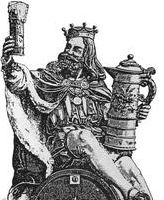
Gambrinus (/ɡæmˈbraɪnəs/ gam-BREE-nəs) is a legendary European culture hero celebrated as an icon of beer, brewing, joviality, and joie de vivre. Typical representations in the visual arts depict him as a rotund, bearded duke or king, holding a tankard or mug, and sometimes with a keg nearby.
Though sometimes erroneously called a patron saint,[1] Gambrinus is neither a saint nor a tutelary deity. It is possible his persona was conflated with traditional medieval saints associated with beermaking, like Saint Arnold of Soissons. In one legendary tradition, he is beer's inventor or envoy. Although legend attributes to him no special powers to bless brews or to make crops grow, tellers of old tall tales are happy to adapt them to fit Gambrinus. Gambrinus stories use folklore motifs common to European folktales, such as the trial by ordeal. Some imagine Gambrinus as a man who has an enormous capacity for drinking beer.[1]
Personages theorised as the basis for the Gambrinus character include the legendary ancient Germanic king Gambrivius (or Gampar) son of Mers[2] (Marsus), John the Fearless of Burgundy (1371–1419) and John I, Duke of Brabant (c. 1252–1294).
- ^ a b Rabin, Dan; Forget, Carl, eds. (1998). "Gambrinus". The Dictionary of Beer and Brewing (2nd ed.). Chicago: Fitzroy Dearborn Publishers. p. 123. ISBN 978-1-57958-078-0. OCLC 40454877.
- ^
Turmair, Johann Georg (1882) [1554]. "44. Von künig Gampar, dem sibenden künig in teutschen landen". In Lexer, Matthias (ed.). Bayerische Chronik [Bavarian Chronicle]. Sämmtliche Werke, Volume 4, Part 1 (in German). Munich: Königliche Akademie der Wissenschaften. p. 126. Retrieved 16 September 2022.
Nach dem Mers ist an das reich kommen sein sun, künig Gampar. zuegenant der Kempher, säxisch Kemper.